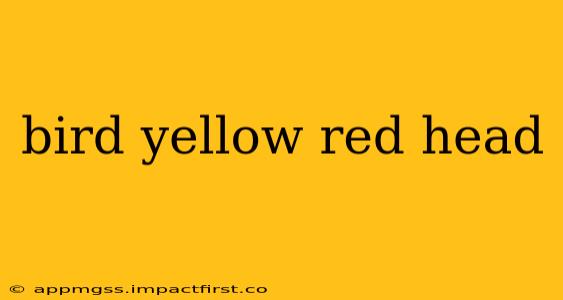Many bird species boast vibrant yellow and red plumage, making identification a fascinating challenge for birdwatchers of all levels. This guide delves into the characteristics of various birds featuring this striking color combination, offering tips to help you accurately pinpoint their species. We'll explore the key features beyond just head color to ensure confident identification.
What are some common birds with yellow and red heads?
Several bird species display a combination of yellow and red on their heads, but the exact shade and pattern vary considerably. Some common examples (depending on geographical location) include certain subspecies of woodpeckers, tanagers, and flycatchers. Precise identification requires careful observation of additional features.
What are the key features to look for besides head color?
Head color is only one piece of the puzzle! To accurately identify a bird with a yellow and red head, you need to consider other crucial characteristics:
- Body plumage: What colors and patterns are present on the rest of the bird's body? Is it predominantly yellow, green, brown, or another color? Are there any stripes, spots, or other markings?
- Size and shape: How big is the bird? What is the shape of its beak, wings, and tail?
- Behavior: What is the bird doing? Is it foraging on the ground, flitting through trees, or singing a particular song?
- Location and habitat: Where did you see the bird? Different species inhabit different environments. Knowing the location significantly narrows down the possibilities.
- Season: Some birds' plumage changes seasonally, affecting the intensity or distribution of their yellow and red markings.
What are some examples of birds with red and yellow heads and their differentiating features?
While a definitive list is challenging due to variations within species and geographical location, here are some examples showcasing the importance of considering features beyond head color:
- Certain Woodpecker Species: Some woodpecker species exhibit red and yellow markings on their heads, but the pattern and extent of these colors vary significantly between species. Consider the beak shape (strong and chisel-like), the overall size, and the habitat (typically wooded areas). Look for further markings on the back and wings.
- Some Tanager Species: Various tanagers exhibit combinations of red and yellow on their heads and bodies. Pay attention to the size, the shape of the bill (often conical), the overall body shape, and the behavior (often found in canopy layers).
- Specific Flycatcher Species: Certain flycatcher species might show yellow and red hues, though it's crucial to observe the wing bars, tail pattern, and overall size and shape to differentiate them from similar-looking birds.
How can I use field guides or online resources to identify birds with yellow and red heads?
Several excellent resources can assist in bird identification. Utilize field guides specific to your region. These guides often include detailed descriptions, illustrations, and range maps to assist in identification. Online resources like eBird, All About Birds, and Merlin Bird ID app provide images, sounds, and range maps, often allowing you to filter by color to narrow your search.
What are some tips for photographing birds for identification purposes?
Clear photographs are invaluable for identification. Try to capture the bird's entire body to show its size and shape. Ensure the image is in focus and shows the bird's plumage details clearly, including any unique markings. If possible, include a size reference (like a ruler or familiar object) in the photo for scale.
By carefully considering all these factors—head color, body plumage, size, shape, behavior, location, and season—you'll be well-equipped to identify birds with yellow and red heads and enhance your birding skills. Remember, practice and patience are key!
